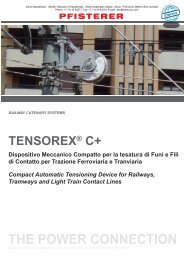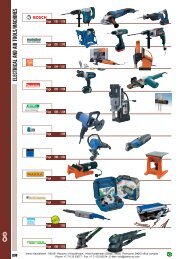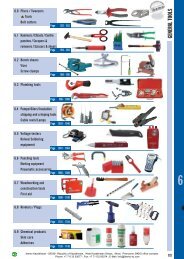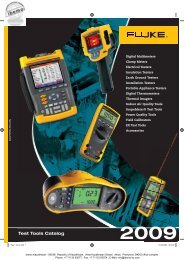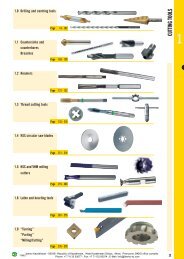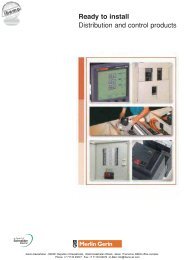General Catalogue 2007 - Ibemo Kazakhstan Ltd
General Catalogue 2007 - Ibemo Kazakhstan Ltd
General Catalogue 2007 - Ibemo Kazakhstan Ltd
Create successful ePaper yourself
Turn your PDF publications into a flip-book with our unique Google optimized e-Paper software.
Both of the new British Standards covering Low Voltage Circuit<br />
Breakers provide the user with a better assurance of quality and<br />
performance by taking into account the actual operating conditions<br />
of the breaker. New definitions and symbols have been introduced<br />
which should be committed to memory. Some of those most<br />
frequently used are:<br />
U : Rated service voltage<br />
e<br />
U : Rated insulation voltage (> Uemax)<br />
i<br />
U : Rated impulse withstand<br />
imp<br />
I : Rated short circuit making capacity<br />
cm<br />
: Rated short circuit capacity<br />
Icn I : Rated service short circuit breaking capacity<br />
cs<br />
I : Rated ultimate short circuit breaking capacity<br />
cu<br />
I : Rated residual operating current (often called residual<br />
Δn<br />
I n<br />
Δ t<br />
3.34<br />
sensitivity)<br />
: Rated current = maximum value of current used for the<br />
temperature rise test<br />
: trip delay of residual current devices<br />
In addition BS EN 60898 sets out to provide a greater degree of<br />
safety to the uninstructed users of circuit breakers. It is interesting<br />
to note that the description “miniature circuit breaker” or MCB is not<br />
used at all in this standard, but no doubt both manufacturers and<br />
users will continue to call circuit breakers complying with BS EN<br />
60898 miniature circuit breakers or MCBs for some time to come.<br />
The scope of this standard is limited to ac air break circuit breakers<br />
for operation at 50Hz or 60Hz, having a rated current not exceeding<br />
125A and a rated short-circuit capacity not exceeding 25kA.<br />
A rated service short-circuit breaking capacity Ics is also included<br />
which is equal to the rated short-circuit capacity Icn for short-circuit<br />
capacity values up to and including 6kA, and 50% of Icn above 6kA<br />
with a minimum value of 7.5kA. As the circuit- breakers covered by<br />
this standard are intended for household and similar uses, Ics is of<br />
academic interest only. The rated short-circuit capacity of a MCB (Icn)<br />
is the alternating component of the prospective current expressed<br />
by its r.m.s. value, which the MCB is designed to make, carry for its<br />
opening time and to break under specified conditions. Icn is shown<br />
on the MCB label in a rectangular box without the suffix ‘A’ and is the<br />
value which is used for application purposes. Icn (of the MCB) should<br />
be equal to or greater than the prospective short-circuit current at the<br />
point of application.<br />
You will see from the curves that the inverse time / current<br />
characteristic which provides overload protection is the same on all<br />
three. This is because the British Standard requires the breaker to<br />
carry 1.13 times the rated current without tripping for at least one<br />
hour and when the test current is increased to 1.45 times the rated<br />
current, it must trip within one hour, and again from cold if the<br />
current is increased to 2.55 times the rated current the breaker must<br />
trip between 1 and 120 seconds. The inverse time delay<br />
characteristic of all MCBs claiming compliance with BS EN 60898<br />
must operate within these limits.<br />
Hager <strong>Catalogue</strong> <strong>2007</strong> • Technical<br />
Circuit Breakers<br />
The difference between the three types of characteristic curves<br />
designated ‘B’, ‘C’ and ‘D’ concerns only the magnetic instantaneous<br />
trip which provides short-circuit protection.<br />
• For type ‘B’ the breaker must trip between the limits of 3 to 5 times<br />
rated current<br />
• For type ‘C” the breaker must trip between the limits of 5 to 10<br />
times rated current, and<br />
• For type ‘D’ the breaker must trip between the limits of 10 to 20<br />
times rated current.<br />
Often manufacturers publish their MCB tripping characteristics showing<br />
the limits set by the standard and guarantee that any<br />
breaker that you purchase will operate within these limits. So great<br />
care should be taken when working with characteristic curves<br />
showing lower and higher limits - on no account should you take a<br />
mean point for application design purposes.<br />
For cable protection applications you should take the maximum<br />
tripping time and some manufacturers publish single line<br />
characteristic curves which show the maximum tripping time. If the<br />
design problem is nuisance tripping then the minimum tripping time<br />
should be used and for desk top co-ordination studies, both lower<br />
and upper limits have to be taken into account.<br />
Energy limiting<br />
Energy is measured in Joules. *James Prescott Joule proved that<br />
thermal energy was produced when an electric current flowed<br />
through a resistance for a certain time, giving us the formula :-<br />
Joules = I2 x R x t or because we know that watts = I2R<br />
Joules = watts x seconds<br />
Therefore we can say that :-<br />
One Joule = one watt second<br />
or energy = watts x seconds = I2 R t<br />
If the resistance (R) remains constant or is very small compared with<br />
the current (I) as in the case of short-circuit current, then energy<br />
becomes proportional to I2t. Which is why the energy let-through of<br />
a protective device is expressed in ampere squared seconds and<br />
referred to as I2t<br />
I2t (Joule Integral) is the integral of the square of the current over a<br />
given time interval (t0, t1)<br />
The I2t characteristic of a circuit breaker is shown as a curve giving<br />
the maximum values of I2t as a function of the prospective current.<br />
Manufacturers are required by the British Standard to produce the I2t<br />
characteristic of their circuit breakers.<br />
See page 3.39.<br />
The energy limiting characteristics of modern MCBs greatly reduce<br />
the damage that might otherwise be caused by short-circuits. They<br />
protect the cable insulation and reduce the risk of fire and other<br />
damage. Knowledge of the energy limiting characteristic of a circuit<br />
breaker also helps the circuit designer calculate discrimination with<br />
other protective devices in the same circuit.<br />
Because of the importance of the energy limiting characteristic the<br />
British Standard for circuit breakers for household and similar<br />
installations suggests three energy limiting classes based on the<br />
permissible I2t (let-through) values for circuit breakers up to 32A;<br />
class 3 having the best energy limiting performance.<br />
All Hager MCBs exceed the requirements for energy let-through set<br />
by the British Standard for energy limiting class 3.<br />
ibemo <strong>Kazakhstan</strong> - 090301 Republic of <strong>Kazakhstan</strong>, West <strong>Kazakhstan</strong> Oblast, Aksai, Pramzone, BKKS office complex<br />
Phone: +7 71133 93077 ; Fax: +7 71133 93074 ; E-Mail: info@ibemo-kz.com



